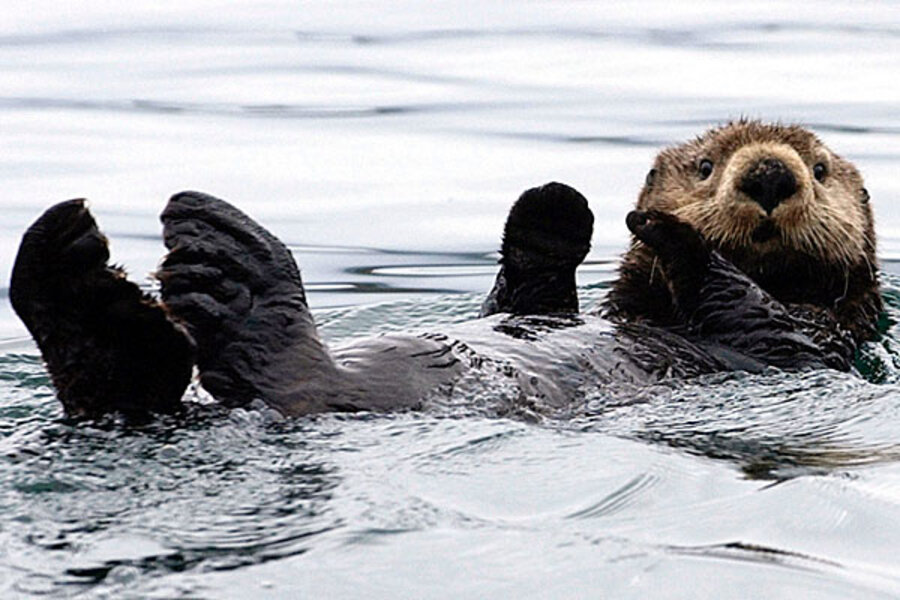Alaska lawmaker wants $100 bounty on sea otters
Loading...
| Juneau, Alaska
An Alaska state senator is proposing a bounty on sea otters, the cute little marine mammals often seen by tourists swimming on their backs between cruise ships, sometimes munching on a fresh crab or clams.
Sen. Bert Stedman, R-Sitka, sees the furry-faced critters as a growing threat to shellfish beds, particularly in southeast Alaska, where he is from. On Wednesday, he introduced legislation that would have the state pay $100 for each sea otter lawfully killed under the federal Marine Mammal Protection Act.
"We're not talking eradication. We're talking slowing the population growth," he said. "In my opinion, we're not going to get any help from the federal government."
Even if the bill were to pass, it would be unenforceable under the federal law, said Bruce Woods, a spokesman for the U.S. Fish and Wildlife Service. States cannot enforce laws or regulations related to the taking of any marine mammal under the law unless the Interior secretary transfers conservation and management authority to that state. That hasn't happened.
Stedman said part of what he is trying to do is begin a discussion on the issue and send a message to the feds that something needs to be done. "Clearly, it's a problem," he said, "and it's going to get worse."
There are three sea otter populations in Alaska, in southwest, south-central and southeast Alaska, whose numbers total an estimated 98,000. The number for the southwest population, listed as threatened under the Endangered Species Act, is the largest, at 55,000, but the latest estimate is more than 10 years old and the population is thought to be in decline, Woods said. Population estimates for the other regions are from 2010-2011. Both those populations are growing, he said.
Since their reintroduction to southeast Alaska by the state in the 1960s, after being virtually wiped out during the fur trade era, the number of sea otters in that region has grown to about 25,000, Woods said. The Marine Mammal Protection Act transferred management authority to Fish and Wildlife in 1972.
Under the federal law, only Alaska Natives can hunt sea otters in Alaska; there is no hunting season and no bag limit, but there are prohibitions on wasteful take — that is, killing sea otters for the sake of killing them, Woods said. At least 840 sea otters were taken for subsistence reasons last year, the highest since 1993, and not surprising given the growing size of the population, wildlife biologist Verena Gill with Fish and Wildlife said.
Fisherman Ladd Norheim of the southeast Alaska community of Petersburg said the sea otters are "decimating" Dungeness crab stocks and would like to see some kind of management. He said half the area he used to fish for Dungeness in southeast Alaska is gone. Three years ago, he said there were 21 Dungeness boats over by Kake. Last year, he said there were two, and one left.
"What strikes me funny: I'm fishing crab right now, and if a crab stock gets low or something or ... any fishery, they shut us off or close us down to protect a crab or a fish. Yet when a sea otter comes in and absolutely decimates an area, they don't do anything about it," he said Thursday. "They just say, 'Oh, they're warm and fuzzy and cute.' Well, I'm pretty warm and fuzzy and cute, too, but I don't totally wipe anything out.
"I mean, crab have rights. Clams have rights. Where do sea otters come out being so holy?" he said.
Woods said he understands the frustrations.
"But our management has to be driven by science," he said. And questions remain about where the population is in terms of its establishment and carrying capacity, and what exact impacts it is having on prey species, like crabs or clams, he said. The agency is working with the University of Alaska Fairbanks to study those issues.
___
Follow Becky Bohrer on Twitter at http://twitter.com/beckybohrerap .
Copyright 2013 The Associated Press.







